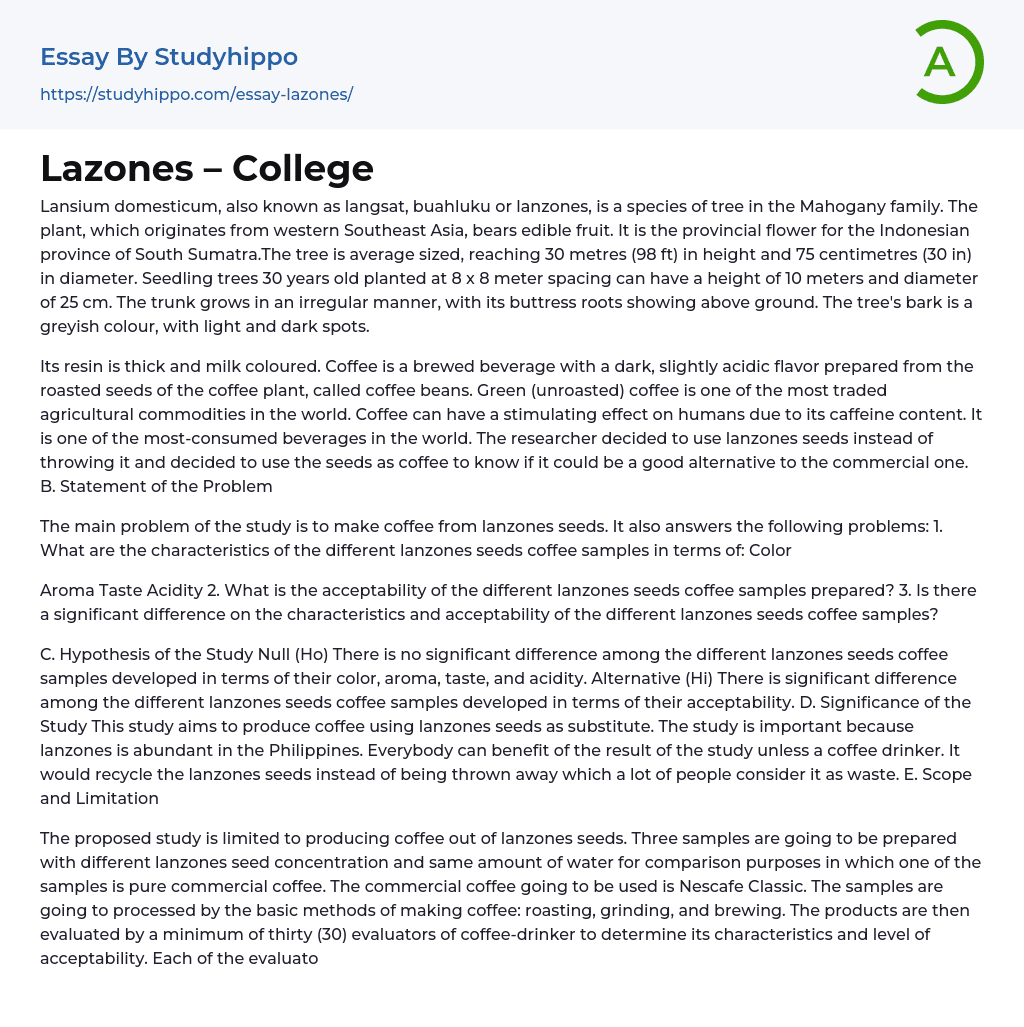The Mahogany family tree known as lansium domesticum, also referred to as langsat, buahluku or lanzones, is native to western Southeast Asia. It produces edible fruit and has been designated as the provincial flower of South Sumatra, Indonesia. Typically reaching a height of about 30 meters (98 ft) and a diameter of 75 centimeters (30 in), this tree can grow up to 10 meters with a diameter of 25 cm within 30 years when seedling trees are planted at an spacing of 8 x 8 meters. The trunk grows in an irregular manner with visible buttress roots above ground level. Additionally, the bark showcases various shades of grey along with light and dark patches.The problem being addressed is finding an alternative to commercial coffee by exploring the potential use of lanzones seeds for producing coffee, rather than discarding them.
The primary goal of the study is to create c
...offee using lanzones seeds. It also aims to investigate the characteristics of different samples of lanzones seed coffee, specifically its color.
The acceptability of the various samples of lanzones seeds coffee, in terms of their aroma, taste, and acidity, is being examined to determine if there are significant differences in their characteristics and acceptability.
The study proposes that there is no significant difference in color, aroma, taste, and acidity between different lanzones seed coffee samples. However, an alternative hypothesis suggests that these samples may vary in their acceptability. The significance of this research lies in its goal to utilize abundant lanzones seeds as an alternative ingredient for coffee production. This has the potential to benefit everyone except for non-coffee drinkers by repurposing what
would otherwise be considered waste. Unfortunately, the specific scope and limitations of the study are not provided.
The study aims to produce coffee using lanzones seeds. Three samples will be prepared, each with a different concentration of lanzones seeds but the same amount of water. One of the samples will be pure commercial coffee, specifically Nescafe Classic. The samples will undergo the basic methods of making coffee: roasting, grinding, and brewing. To determine the characteristics and level of acceptability, a minimum of thirty evaluators who are coffee-drinkers will assess the products. Each evaluator will be given an individual score sheet to evaluate each sample. The experiment will take place at the researcher's residence in 2015. F. Conceptual Framework
Scientific Name: Lansium domesticum. Lanzones is a species of fruit-bearing tree from the family Meliaceae. It is native to Malaysia and Indonesia. In the Philippines, Lanzones is abundant from July to November, during the rainy season. It is mostly grown in parts of Paete, Laguna, and also in the Northern part of Mindanao, such as Butuan, Cagayon de Oro, and Camiguin (known for their Lanzones festival).
Lanzones has various health benefits. It contains Vitamin C and E and is a good source of antioxidants. Additionally, it has been found to prevent diarrhea, as I have personally experienced the effectiveness by consuming the fruit meat.
Lanzones has a sweet taste that varies based on ripeness and quality. It is incredibly enjoyable to eat and once you start, it's hard to stop, despite the bitterness of the seed, which some people still eat. The outer covering of the fruit has a brown color, but once you peel it,
the juicy white meat is very easy to consume.
Lanzones, also known as Lansium domesticum, is a fruit-bearing tree that belongs to the Meliaceae family. This tree has compound leaves with pinnate structure, ranging from twenty to fifty centimeters in length per leaf. Each leaf consists of five to seven obovate leaflets with a slightly leathery texture, reaching a length of twenty centimeters each. The dark green, glossy leaflets are defined by a prominent midrib. The fruits of this tree are ovoid and round orbs, approximately five centimeters in diameter, usually found in clusters of two to thirty along the branches and trunk.
The fruit possesses a circular form and is distinguished by its yellowish, thick, tough skin. It is segmented into five or six slices of see-through, succulent flesh. The flavor of the flesh is mildly acidic, but as it ripens fully, it becomes sweeter. Roughly half of the sections contain green seeds, which may be found in a small portion or throughout the entire volume. In contrast to the sweet-sour taste of the flesh, the seeds are exceedingly bitter. Some individuals describe this fruit as a blend of grape and an "ideal" grapefruit lacking any bitterness. However, if one were to bite into the seeds themselves, they possess a stronger bitterness akin to that discovered in grapefruit. The succulent flesh contains sucrose, fructose, and glucose.
- Professor essays
- Should College be Free essays
- Should college athletes be paid essays
- College Education essays
- College Tuition essays
- Graduation essays
- College Goals essays
- Personal Statement essays
- Online Classes Vs Traditional Classes essays
- Online Education essays
- Student Loan essays
- Study Abroad Scholarship essays
- Reasons To Go To College essays
- Paying College Athletes essays
- Technology In The Classroom essays
- Agriculture essays
- Albert einstein essays
- Animals essays
- Archaeology essays
- Bear essays
- Biology essays
- Birds essays
- Butterfly essays
- Cat essays
- Charles Darwin essays
- Chemistry essays
- Dinosaur essays
- Discovery essays
- Dolphin essays
- Elephant essays
- Eli Whitney essays
- Environmental Science essays
- Evolution essays
- Fish essays
- Genetics essays
- Horse essays
- Human Evolution essays
- Isaac Newton essays
- Journal essays
- Linguistics essays
- Lion essays
- Logic essays
- Mars essays
- Methodology essays
- Mineralogy essays
- Monkey essays
- Moon essays
- Mythology essays
- Noam Chomsky essays
- Physics essays




